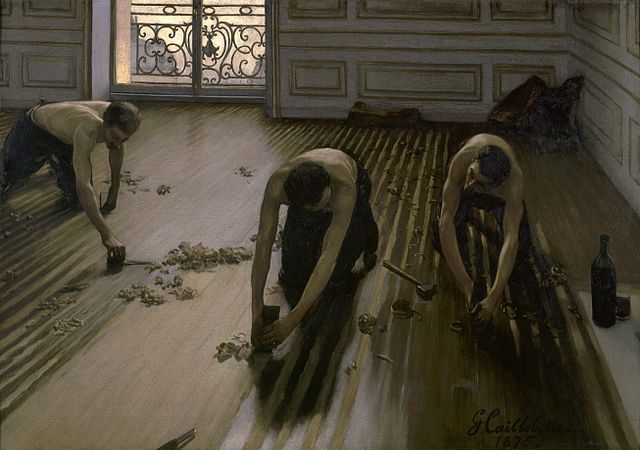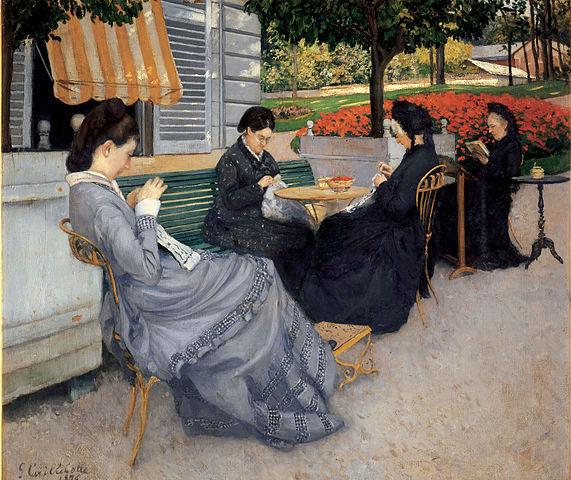
Students who choose to study in the conference room area on the U2 level of the Pridi Banomyong Library may have noticed a reproduction of a painting on one of the walls. It is The Floor Scrapers by the French painter Gustave Caillebotte. The TU Library owns a book about French art, with a chapter on Caillebotte. The original of this painting is in the collection of the Orsay Museum in Paris, France. The Orsay Museum specializes in art of the 1800s. The Floor Scrapers, also known as The Floor Planers, shows some workers removing the top level of a wooden floor in a Paris apartment.
Why are they doing that? The original French title of the painting is Les raboteurs de parquet. As students in the TU Faculty of Architecture know, parquet is a kind of flooring made up of wooden blocks arranged in a geometric pattern. In the 1800s, before mechanical instruments were invented, people scraped wooden floors to make them look new. Old or discolored varnishes and shellac would be removed, making the wood look brighter and fresher.
Today, in Western countries, old style wood flooring is sometimes treated to show that the apartment and building they are found in are not brand new. It is considered stylish to show how old the building and floor are. To do so, the floors are scraped by hand, making them look somewhat worn. The TU Library also has a number of books about wooden architecture and construction techniques.
In the painting, we see that three workers are kneeling on the floor. They have put pads under their knees, to avoid hurting them. They use instruments, including a scraper and a plane. A hand plane is used to shape wood by forcing the cutting blade over the wood surface. In the days before mechanical planes, this took a lot of energy.
TU students who are familiar with building and construction have probably seen more rotary power planers which are motorized. Caillebotte painted The Floor Scrapers, before such inventions were available. Even today, some workers who are trying to do delicate or detailed planning prefer a miniature hand plane to a mechanical one, which is less easy to control. Planes are used to flatten and smooths surfaces of wood. In Caillebotte’s painting, one of the workers appears to be speaking to another one. The third is busy getting a chisel. A chisel has a blade on its end for carving or cutting wood or other materials. There is also a hammer in the painting, but no one is using it for the moment. On the side is an opened bottle of wine and a glass half full. Either the workers have already had lunch or they are looking forward to having lunch with wine.

We can see from lots of pieces of scraped wood surface that the workers have been busy for a while. After scraping, they may be planning to go over the floor again with sandpaper to further smooth out the surface. Then they will eventually apply new varnish or drying oil to the floor to protect it from moisture and other potential wear and tear. Varnish is applied, then allowed to dry for 24 hours before a second coat of varnish is applied. Some art historians have noted that although the workers have removed their shirts, suggesting that it is warm inside the room, the window at the back of the room is closed.
This may be because they are working in wintertime, or possibly because on a windy day, an open window would cause all the piles of scraped wood to fly around messily. When the workmen would apply the varnish later, it would be necessary to open windows, since it can be toxic to breathe in the varnish fumes in a room with closed windows.
After the varnish has been applied, then drying oils were added in two coats. Again, the workers would wait for 24 hours before adding the second coat. Finally, they would add wax in liquid or paste form. This would give the floor a shine and protect it most effectively.
The Floor Scrapers reminds us of the amount of wood involved in taking care of a house or apartment. In some ways, there is so much care taken with planning a floor that it is comparable to the process of a painter creating a canvas. Names of excellent painters are usually remembered in the modern era, while names of highly accomplished floor planers tend to be forgotten.
Some art historians suggest that Caillebotte painted the workers in his studio in an expensive neighborhood of Paris, the 8th arrondissement of Paris, where apartments cost a lot of money, even at the time of Caillebotte. The artist’s father made a fortune selling textiles to the French Army to make military uniforms. Caillebotte earned a law degree and passed the bar exam, so he could have practiced law if he had wished. He also studied engineering. He finally decided that he preferred his hobby of painting, even though he did not spend much time in art school.
Art critics did not appreciate The Floor Scrapers when it was first exhibited. They felt that the subject matter of people working on a floor was too ordinary. In Caillebotte’s time, it was thought that farmers or agricultural workers were acceptable subjects in painting. Creating paintings inspired by city workers was thought to be low class. Even after Caillebotte died and the painting was donated to a French museum, it was not exhibited, until the painter’s family and friends insisted.
Other paintings by Caillebotte that were donated to French museums were also unpopular at first. They were seen as too close to photographs, and people did not enjoy them. The author and journalist Émile Zola wrote about The Floor Scrapers in the 1870s:
It is a completely anti-artistic painting, a painting clear like glass, of a middle-class kind by its exactitude. The photography of reality, when it is not enhanced by the original print of artistic talent, is a pitiful thing… When his talent will have softened a little, Mr. Caillebotte will certainly be one of the boldest of the group.
The TU Library has many books by and about Zola. Since Caillebotte had plenty of money, he did not worry too much if critics did not appreciate his art. He would often buy paintings by his friends, some of them famous Impressionist painters such as Pierre-Auguste Renoir, Claude Monet, Édouard Manet, and Camille Pissarro. The TU Library has books on these painters and reproductions of some of their works are on view in the Pridi Banomyong Library.
Since then, more people have admired the painting, and in 1988 a ballet was staged in Paris in tribute to The Floor Scrapers.

(All images courtesy of Wikimedia Commons)
